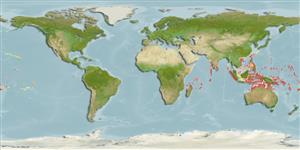Environment: milieu / climate zone / depth range / distribution range
Écologie
marin récifal; profondeur 8 - 30 m (Ref. 90102). Tropical; 30°N - 18°S
Indo-Pacific: East Africa to the Society Islands, north to Ryukyu Islands and south to Australia.
Taille / Poids / Âge
Maturity: Lm ? range ? - ? cm
Max length : 13.2 cm TL mâle / non sexé; (Ref. 90102)
Épines dorsales (Total) : 7; Rayons mous dorsaux (Total) : 12 - 13; Épines anales: 3; Rayons mous anaux: 9. Body and fins dull yellowish brown; prominent dark ocellus on opercle; dark brown spot on each side of chin (Ref. 4326).
Found on coral heads of lagoon and seaward reefs from 3 to at least 15 m (Ref. 1602). Solitary or in pairs, seldom seen (Ref 90102).
Life cycle and mating behavior
Maturities | Reproduction | Spawnings | Egg(s) | Fecundities | Larves
Paxton, J.R., D.F. Hoese, G.R. Allen and J.E. Hanley, 1989. Pisces. Petromyzontidae to Carangidae. Zoological Catalogue of Australia, Vol. 7. Australian Government Publishing Service, Canberra, 665 p. (Ref. 7300)
Statut dans la liste rouge de l'IUCN (Ref. 130435)
Menace pour l'homme
Harmless
Utilisations par l'homme
Outils
Articles particuliers
Télécharger en XML
Sources Internet
Estimates based on models
Preferred temperature (Ref.
123201): 26.4 - 28.9, mean 27.9 °C (based on 198 cells).
Phylogenetic diversity index (Ref.
82804): PD
50 = 1.0000 [Uniqueness, from 0.5 = low to 2.0 = high].
Bayesian length-weight: a=0.00427 (0.00166 - 0.01096), b=3.17 (2.94 - 3.40), in cm total length, based on LWR estimates for this (Sub)family-body shape (Ref.
93245).
Niveau trophique (Ref.
69278): 3.7 ±0.6 se; based on size and trophs of closest relatives
Fishing Vulnerability (Ref.
59153): Low vulnerability (10 of 100).
Nutrients (Ref.
124155): Calcium = 95.8 [53.5, 202.0] mg/100g; Iron = 0.676 [0.341, 1.254] mg/100g; Protein = 18 [16, 20] %; Omega3 = 0.111 [0.062, 0.204] g/100g; Selenium = 26.3 [12.2, 57.0] μg/100g; VitaminA = 145 [44, 526] μg/100g; Zinc = 1.53 [0.96, 2.31] mg/100g (wet weight);
